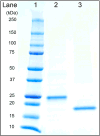Characterization of secondary structure and lipid binding behavior of N-terminal saposin like subdomain of human Wnt3a
- PMID: 28754322
- PMCID: PMC5572759
- DOI: 10.1016/j.abb.2017.07.015
Characterization of secondary structure and lipid binding behavior of N-terminal saposin like subdomain of human Wnt3a
Abstract
Wnt signaling is essential for embryonic development and adult homeostasis in multicellular organisms. A conserved feature among Wnt family proteins is the presence of two structural domains. Within the N-terminal (NT) domain there exists a motif that is superimposable upon saposin-like protein (SAPLIP) family members. SAPLIPs are found in plants, microbes and animals and possess lipid surface seeking activity. To investigate the function of the Wnt3a saposin-like subdomain (SLD), recombinant SLD was studied in isolation. Bacterial expression of this Wnt fragment was achieved only when the core SLD included 82 NT residues of Wnt3a (NT-SLD). Unlike SAPLIPs, NT-SLD required the presence of detergent to achieve solubility at neutral pH. Deletion of two hairpin loop extensions present in NT-SLD, but not other SAPLIPs, had no effect on the solubility properties of NT-SLD. Far UV circular dichroism spectroscopy of NT-SLD yielded 50-60% α-helix secondary structure. Limited proteolysis of isolated NT-SLD in buffer and detergent micelles showed no differences in cleavage kinetics. Unlike prototypical saposins, NT-SLD exhibited weak membrane-binding affinity and lacked cell lytic activity. In cell-based canonical Wnt signaling assays, NT-SLD was unable to induce stabilization of β-catenin or modulate the extent of β-catenin stabilization induced by full-length Wnt3a. Taken together, the results indicate neighboring structural elements within full-length Wnt3a affect SLD conformational stability. Moreover, SLD function(s) in Wnt proteins appear to have evolved away from those commonly attributed to SAPLIP family members.
Keywords: Canonical Wnt signal transduction; Circular dichroism spectroscopy; Limited proteolysis; Liposomes; Saposin; Wnt3a.
Copyright © 2017 Elsevier Inc. All rights reserved.
Figures








Similar articles
-
Isolation and characterization of recombinant murine Wnt3a.Protein Expr Purif. 2015 Feb;106:41-8. doi: 10.1016/j.pep.2014.10.015. Epub 2014 Nov 8. Protein Expr Purif. 2015. PMID: 25448592 Free PMC article.
-
Disulfide bond requirements for active Wnt ligands.J Biol Chem. 2014 Jun 27;289(26):18122-36. doi: 10.1074/jbc.M114.575027. Epub 2014 May 19. J Biol Chem. 2014. PMID: 24841207 Free PMC article.
-
Mechanistic insights into the lipid interaction of an ancient saposin-like protein.Biochemistry. 2015 Mar 10;54(9):1778-86. doi: 10.1021/acs.biochem.5b00094. Epub 2015 Feb 26. Biochemistry. 2015. PMID: 25715682
-
Wnt3a stimulates Mepe, matrix extracellular phosphoglycoprotein, expression directly by the activation of the canonical Wnt signaling pathway and indirectly through the stimulation of autocrine Bmp-2 expression.J Cell Physiol. 2012 Jun;227(6):2287-96. doi: 10.1002/jcp.24038. J Cell Physiol. 2012. PMID: 22213482
-
Saposin-like proteins (SAPLIP) carry out diverse functions on a common backbone structure.J Lipid Res. 1995 Aug;36(8):1653-63. J Lipid Res. 1995. PMID: 7595087 Review. No abstract available.
References
Publication types
MeSH terms
Substances
Grants and funding
LinkOut - more resources
Full Text Sources
Other Literature Sources
Research Materials

